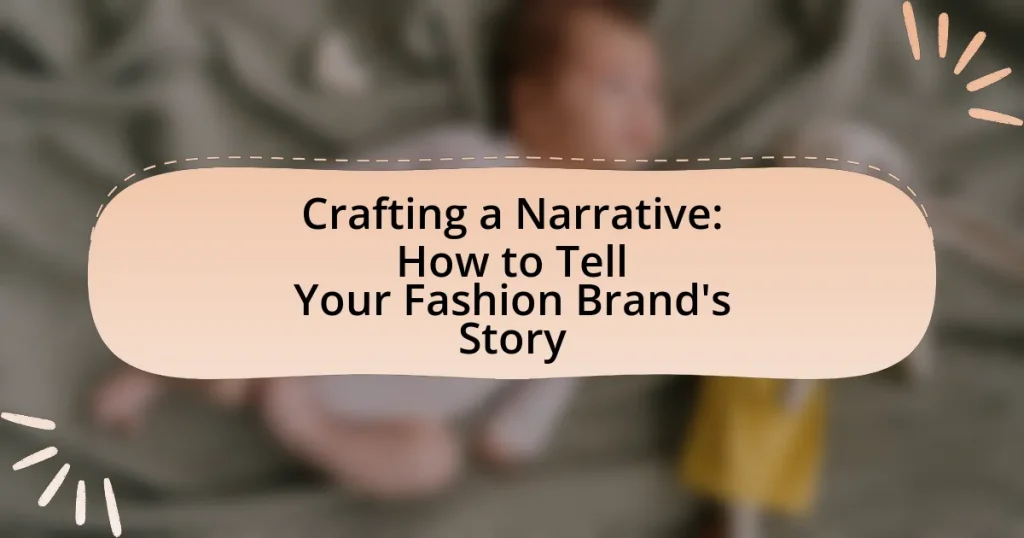Crafting a narrative for a fashion brand is a strategic process that involves developing a compelling story to communicate the brand’s values, mission, and identity. This article explores the significance of storytelling in the fashion industry, emphasizing its role in fostering emotional connections and brand loyalty among consumers. Key elements of a brand’s story, such as origin, mission, and values, are discussed, along with the importance of authenticity and personal experiences in shaping narratives. Additionally, the article outlines methods for identifying and adapting a brand’s unique story, effective communication strategies, and common pitfalls to avoid, providing practical tips for fashion brands to enhance their storytelling efforts.

What is Crafting a Narrative for a Fashion Brand?
Crafting a narrative for a fashion brand involves creating a compelling story that communicates the brand’s values, mission, and identity to its audience. This process is essential for establishing an emotional connection with consumers, as it helps differentiate the brand in a competitive market. For instance, brands like Patagonia effectively use storytelling to highlight their commitment to environmental sustainability, which resonates with their target audience and enhances brand loyalty.
Why is storytelling important in the fashion industry?
Storytelling is important in the fashion industry because it creates emotional connections between brands and consumers. This emotional engagement fosters brand loyalty, as consumers are more likely to support brands that resonate with their values and experiences. For instance, brands like Patagonia effectively use storytelling to highlight their commitment to environmental sustainability, which appeals to eco-conscious consumers. Research indicates that 55% of consumers are more likely to purchase from a brand that tells a compelling story, demonstrating the tangible impact of narrative on consumer behavior.
How does a compelling narrative influence consumer perception?
A compelling narrative significantly influences consumer perception by creating an emotional connection and enhancing brand loyalty. When consumers engage with a brand’s story, they are more likely to relate to its values and mission, which can lead to increased trust and preference for that brand. Research indicates that narratives can improve memory retention and information processing, making consumers more likely to remember and favor brands that tell compelling stories. For instance, a study published in the Journal of Consumer Research found that storytelling can increase the likelihood of purchase by 55% compared to traditional advertising methods. This demonstrates that a well-crafted narrative not only captures attention but also shapes how consumers perceive and interact with a brand.
What role does authenticity play in brand storytelling?
Authenticity is crucial in brand storytelling as it fosters trust and emotional connection with consumers. When brands present genuine narratives that reflect their values and mission, they resonate more deeply with their audience, leading to increased loyalty and engagement. Research by the Harvard Business Review indicates that consumers are 55% more likely to purchase from brands they perceive as authentic. This connection is particularly vital in the fashion industry, where consumers increasingly seek transparency and ethical practices. Thus, authenticity not only enhances brand reputation but also drives consumer behavior and purchasing decisions.
What are the key elements of a fashion brand’s story?
The key elements of a fashion brand’s story include the brand’s origin, mission, values, target audience, and unique selling proposition. The origin provides context about how the brand was founded, often highlighting personal experiences or inspirations that led to its creation. The mission defines the brand’s purpose and what it aims to achieve in the fashion industry, while values reflect the principles that guide its operations and interactions with customers. Understanding the target audience is crucial, as it shapes the brand’s messaging and product offerings. Lastly, the unique selling proposition distinguishes the brand from competitors, emphasizing what makes it special or different. These elements collectively create a compelling narrative that resonates with consumers and fosters brand loyalty.
How do brand values shape the narrative?
Brand values shape the narrative by providing a foundational framework that guides storytelling and communication strategies. These values influence how a brand presents itself, connects with its audience, and differentiates itself in the market. For example, a fashion brand that prioritizes sustainability will craft narratives that highlight eco-friendly practices, ethical sourcing, and social responsibility, thereby attracting consumers who share those values. Research indicates that 66% of consumers are willing to pay more for sustainable brands, demonstrating that aligning brand values with consumer expectations can enhance brand loyalty and engagement.
What impact do personal experiences have on storytelling?
Personal experiences significantly enhance storytelling by adding authenticity and emotional depth. When storytellers incorporate their own life events, they create relatable narratives that resonate with audiences, fostering a deeper connection. Research indicates that stories grounded in personal experiences are more memorable; for instance, a study published in the journal “Cognitive Science” found that narratives with personal relevance are retained better by listeners. This connection not only engages the audience but also establishes trust, making the storytelling more impactful, especially in contexts like fashion branding where personal narratives can differentiate a brand in a competitive market.
How can a fashion brand identify its unique story?
A fashion brand can identify its unique story by analyzing its core values, target audience, and the inspiration behind its designs. This process involves reflecting on the brand’s mission, the cultural or personal influences that shape its aesthetic, and the emotional connections it aims to create with consumers. For instance, brands like Patagonia emphasize environmental sustainability as a core value, which informs their narrative and resonates with eco-conscious consumers. By conducting market research and gathering customer feedback, a brand can further refine its story to ensure it aligns with the expectations and aspirations of its audience.
What methods can brands use to discover their narrative?
Brands can discover their narrative through methods such as customer interviews, market research, and storytelling workshops. Customer interviews provide direct insights into consumer perceptions and values, allowing brands to align their narrative with audience expectations. Market research helps identify trends and gaps in the industry, enabling brands to position their story effectively. Storytelling workshops facilitate creative brainstorming sessions, encouraging collaboration among team members to articulate a cohesive brand narrative. These methods collectively ensure that the narrative resonates with the target audience and reflects the brand’s core values.
How can market research inform a brand’s story?
Market research can inform a brand’s story by providing insights into consumer preferences, behaviors, and trends. This data allows brands to tailor their narratives to resonate with their target audience, ensuring relevance and engagement. For instance, a study by Nielsen found that 66% of consumers are willing to pay more for brands that are transparent about their values and practices, highlighting the importance of aligning a brand’s story with consumer expectations. By analyzing feedback, demographics, and market trends, brands can craft compelling stories that reflect their audience’s values and aspirations, ultimately enhancing brand loyalty and connection.
How does a fashion brand’s narrative evolve over time?
A fashion brand’s narrative evolves over time through strategic adaptations to cultural trends, consumer preferences, and market dynamics. Initially, a brand establishes its identity through core values and unique storytelling, which resonate with its target audience. As societal values shift, brands may incorporate sustainability, inclusivity, or technological advancements into their narratives to remain relevant. For example, brands like Patagonia have successfully integrated environmental activism into their story, reflecting a growing consumer demand for sustainability. Additionally, collaborations with influencers or other brands can refresh a narrative, attracting new demographics and revitalizing interest. This evolution is essential for maintaining brand loyalty and competitive advantage in a rapidly changing industry.
What factors contribute to changes in a brand’s story?
Changes in a brand’s story are primarily influenced by shifts in consumer preferences, market trends, and societal values. Consumer preferences evolve due to factors such as demographic changes, technological advancements, and cultural movements, prompting brands to adapt their narratives to remain relevant. Market trends, including competitive dynamics and economic conditions, also necessitate adjustments in storytelling to align with current demands. Additionally, societal values, such as sustainability and inclusivity, can drive brands to reshape their narratives to reflect a commitment to these principles, thereby enhancing brand loyalty and engagement. For instance, brands like Patagonia have successfully altered their stories to emphasize environmental responsibility, resonating with a growing consumer base that prioritizes sustainability.
How can brands adapt their narratives to stay relevant?
Brands can adapt their narratives to stay relevant by continuously aligning their messaging with evolving consumer values and societal trends. This involves actively listening to customer feedback, analyzing market shifts, and integrating current cultural conversations into their storytelling. For instance, brands like Nike have successfully adapted their narratives by embracing social justice themes, which resonate with younger consumers, leading to increased brand loyalty and sales. According to a 2021 report by McKinsey, brands that effectively engage with social issues can see a 20% increase in customer engagement.
What are effective strategies for communicating a fashion brand’s story?
Effective strategies for communicating a fashion brand’s story include utilizing authentic storytelling, leveraging visual content, and engaging with the audience through social media. Authentic storytelling allows brands to connect emotionally with consumers by sharing their origins, values, and mission, which fosters brand loyalty. Visual content, such as high-quality images and videos, enhances the narrative by showcasing products in relatable contexts, making the story more engaging. Social media platforms facilitate direct interaction with the audience, enabling brands to share their stories in real-time and receive immediate feedback, which can further refine the narrative. These strategies are supported by research indicating that brands with strong narratives can achieve up to 20% higher customer engagement rates compared to those without a clear story.
How can visual elements enhance storytelling?
Visual elements enhance storytelling by creating emotional connections and improving audience engagement. For instance, images, colors, and typography can evoke specific feelings and set the tone of the narrative, making it more relatable and memorable. Research indicates that visuals can increase information retention by up to 65%, as they help to illustrate concepts and ideas more effectively than text alone. This is particularly relevant in fashion branding, where visual storytelling can showcase products and lifestyles, thereby influencing consumer perceptions and decisions.
What platforms are best for sharing a brand’s narrative?
The best platforms for sharing a brand’s narrative include social media channels like Instagram, Facebook, and TikTok, as well as blogs and websites. These platforms allow brands to visually and textually communicate their stories, engage with audiences, and build community. For instance, Instagram’s visual-centric approach is particularly effective for fashion brands, with 67% of users stating that they discover new products on the platform. Additionally, blogs can provide in-depth storytelling, enhancing brand authenticity and connection with consumers.
How can storytelling drive customer engagement and loyalty?
Storytelling drives customer engagement and loyalty by creating emotional connections between brands and consumers. When brands share compelling narratives, they resonate with customers’ values and experiences, fostering a sense of belonging. Research indicates that 55% of consumers are more likely to purchase from a brand that tells a story they can relate to, as highlighted in a study by the Content Marketing Institute. This emotional engagement not only enhances customer retention but also encourages word-of-mouth referrals, further solidifying brand loyalty.
What techniques can brands use to connect emotionally with consumers?
Brands can connect emotionally with consumers by utilizing storytelling, personalization, and social responsibility. Storytelling allows brands to create relatable narratives that resonate with consumers’ values and experiences, fostering a deeper emotional connection. Personalization enhances this connection by tailoring messages and experiences to individual preferences, making consumers feel valued and understood. Additionally, brands that engage in social responsibility demonstrate a commitment to causes that matter to their audience, further strengthening emotional ties. For instance, a study by the Harvard Business Review found that emotionally connected customers are more than twice as valuable as highly satisfied customers, highlighting the effectiveness of these techniques in building loyalty and engagement.
How does storytelling influence repeat purchases?
Storytelling significantly influences repeat purchases by creating emotional connections between consumers and brands. When brands effectively communicate their narratives, they foster loyalty and trust, which are critical for encouraging customers to return. Research indicates that 55% of consumers are more likely to make repeat purchases from brands that tell compelling stories, as these narratives resonate with their values and experiences. This emotional engagement not only enhances customer retention but also drives word-of-mouth referrals, further amplifying brand loyalty.
What are common pitfalls to avoid in fashion brand storytelling?
Common pitfalls to avoid in fashion brand storytelling include lack of authenticity, inconsistency in messaging, and neglecting the target audience. Authenticity is crucial; brands that fail to present a genuine narrative risk losing consumer trust, as evidenced by studies showing that 86% of consumers value authenticity in brand storytelling. Inconsistency can confuse consumers and dilute brand identity, leading to a fragmented perception of the brand. Additionally, neglecting the target audience can result in storytelling that does not resonate, as effective narratives should align with the values and interests of the intended demographic.
How can brands ensure they remain authentic in their narratives?
Brands can ensure they remain authentic in their narratives by consistently aligning their messaging with their core values and mission. This alignment fosters trust and credibility among consumers, as authenticity is rooted in transparency and honesty. For instance, a study by the Harvard Business Review found that 64% of consumers cite shared values as the primary reason they have a relationship with a brand. By actively engaging with their audience and incorporating feedback, brands can further reinforce their authenticity, ensuring that their narratives resonate with their target market while reflecting genuine practices and beliefs.
What mistakes can dilute a brand’s story?
Mistakes that can dilute a brand’s story include inconsistency in messaging, lack of authenticity, and failure to engage the target audience. Inconsistency in messaging can confuse consumers, leading to a fragmented brand identity; for instance, if a brand promotes sustainability but uses non-eco-friendly materials, it undermines its narrative. Lack of authenticity can alienate customers; brands that do not genuinely embody their stated values risk being perceived as insincere. Additionally, failing to engage the target audience through relevant storytelling can result in a disconnect, as seen in brands that do not adapt their narratives to resonate with evolving consumer preferences. These mistakes collectively weaken the brand’s overall impact and recognition in the market.
What practical tips can help fashion brands craft their narrative effectively?
Fashion brands can craft their narrative effectively by focusing on authenticity, emotional connection, and storytelling techniques. Authenticity ensures that the brand’s message resonates with consumers, as studies show that 86% of consumers value authenticity in brands. Establishing an emotional connection through relatable stories can enhance customer loyalty, with research indicating that emotionally connected customers are more than twice as valuable as highly satisfied customers. Utilizing storytelling techniques, such as highlighting the brand’s origins, values, and mission, can create a compelling narrative that engages the audience. For instance, brands like Patagonia successfully communicate their commitment to environmental sustainability, which strengthens their narrative and attracts like-minded consumers.



